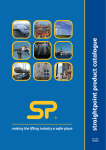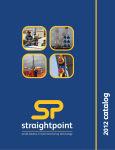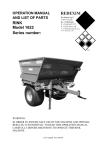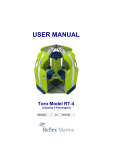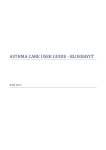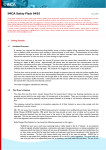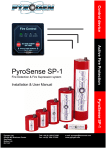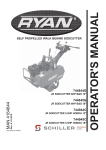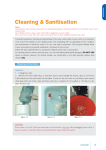Download IMCA Safety Flash 07/11
Transcript
AB IMCA Safety Flash 07/11 Safety Flash July 2011 These flashes summarise key safety matters and incidents, allowing wider dissemination of lessons learnt from them. The information below has been provided in good faith by members and should be reviewed individually by recipients, who will determine its relevance to their own operations. The effectiveness of the IMCA safety flash system depends on receiving reports from members in order to pass on information and avoid repeat incidents. Please consider adding the IMCA secretariat ([email protected]) to your internal distribution list for safety alerts and/or manually submitting information on specific incidents you consider may be relevant. All information will be anonymised or sanitised, as appropriate. A number of other organisations issue safety flashes and similar documents which may be of interest to IMCA members. Where these are particularly relevant, these may be summarised or highlighted here. Links to known relevant websites are provided at www.imca-int.com/links Additional links should be submitted to [email protected] 1 Reliance on Crane Limits Caused Crane Damage and Dropped Objects A member has reported an incident in which a crane was damaged and objects fell to the deck in the vicinity of personnel. The incident occurred when a crane operator, whilst attempting to stow the block during the hours of darkness, had difficulties in seeing it due to poor lighting conditions and the boom angle of the crane. Consequently, the crane operator relied on his upper crane limits to stop the block. The upper limit switch failed to operate due to a technical fault and the wire socket was pulled into the sheave causing damage to the sheave, wire and rope guard. Sheared bolt heads from the rope guard then fell to deck in the vicinity of personnel below. The crane operator then immediately lowered the block to position where he could cancel the alarms which were now sounding. This action itself could have released further potential dropped objects which may have been held in place by the block. An investigation noted the following points: The incident took place during a routine task and was considered low risk, but had the potential for a fatality or serious permanent injury had a larger component fallen and struck any of the personnel below. Additionally, there could have been a substantial impact on the project or vessel schedule with the crane being out of service for a long period of time; A significant contributory factor in this incident was the failure of the crane upper limit switch to automatically stop the wire socket well in advance of the rope guard and sheave. However, the crane operator failed to perceive the risk of ‘two blocking’ the crane even when faced with poor visibility of the boom tip, and relied upon the limit switch to safely stow the block; The lighting conditions, boom angle and poor visibility should have prompted the crane operator to request assistance from the deck crew. As soon as the incident had occurred, the situation should have been assessed prior to lowering the block and possibly releasing any potential dropped objects. Actions taken included: Highlighting the fact that reliance on crane limits should not be the primary method for stowing the block when visibility is poor or restricted; Banksmen should be in attendance to give the crane operator assistance when stowing the block, and reference to this should be made be on the toolbox talk form for this task; Crane operators should ensure that all limits are checked at the correct intervals in accordance with manufacturer’s instructions. 2 Galley Fryer Fire A member has reported an incident in which a fire occurred during routine cleaning and operation of a twin vat deep fat fryer onboard a vessel. The night shift galley team were given the task of cleaning a twin vat deep fat fryer. This task was carried out by them, however on completion only one of the twin vats was refilled with oil. This fact was not communicated to the day shift galley team. The day shift team were required to use the fryer shortly after starting work, and it was switched on by one of the stewards without any pre-start checks being carried out. Shortly after the fryer was switched on a small fire started in the left-hand (empty) vat, which was quickly extinguished by the cook. There were no injuries and little damage occurred. Galley deep fat fryer The incident was investigated and the following was noted: No procedure existed detailing that the fryer should be refilled after cleaning; The risk assessment did not identify the risk of fire if the unit was switched on without oil being at the required level in the vat; The galley team shift handover was inadequate; The galley team had inadequate knowledge of the fryer operation; The unit was routinely being switched on at the main isolation point, despite there being two thermostatic controls to operate the vats independently of one another; Not all galley staff had the confidence to tackle the fire, and had not attended recent emergency drills; This was the second deep fat fryer fire on a company vessel in the previous six months, both having similar causes. It was noted that a fire risk with deep fat fryers will always exist where personnel are not adequately trained in the correct operation and maintenance of such equipment. It was also noted that key errors were made where the unit was left without oil in one vat and then switched on with no check made that it was functioning correctly, and that there were no control measures in place for the cleaning of the fryer. The following actions weere outlined: Ensure that the processes and procedures concerning the fryers are suitable and that sufficient controls are in place for their safe operation and maintenance; Ensure that the risk assessment for the fryers and galley equipment is suitable and sufficient, and understood by all; Ensure that all the galley staff have been fully familiarised with all the galley equipment and fully understand the operation and risks for each; Ensure that all members of the galley team are regularly trained in emergency requirements. 3 Shackle in Rigging Assembly Below Required Safe Working Load (SWL) A member has reported that during a recent a recent spot check on a lifting bridle it was identified that a 17T shackle had been fitted instead of a 30T shackle. The preassembled lifting bridle included 3 x 30T shackles (Crosby G2140) and 1 x 17T (Crosby G2130) instead of 4 x 30T shackles. The certificate for the 17T shackle was cross checked against the identification number on the attached tag plate and showed the shackle SWL as 30T. The shackle was removed and replaced with a 30T shackle (30T working load limit (WLL) embossed). Although the shackles are almost identical in size, differences in the material grades determine the WLL. Both the material grade and WLL are embossed on every shackle. It appears that an error was made during the certification process by the supplier where a 17T shackle had been certified (ID tag attached with common certificate number) as part of a batch of 30T shackles. This unsafe condition reinforces the requirement to conduct a pre-use inspection of lifting equipment prior to commencing the lift. Different shackles with working load limits embossed 4 Near Miss: Personnel Almost Caught Between Crane House and Scaffold Pipe A member has reported an incident in which someone was almost caught between a crane housing and a scaffold pipe. The incident occurred when a non-destructive testing (NDT) inspector was conducting an inspection at the stern of the crane, outside on the roller level. The access was from the scaffold around the crane. The inspector was positioned at a beam, behind a vertical scaffold pole. He had just finished the inspection of the welds and stepped back from the crane housing onto the scaffold platform when the crane started slewing. A deck supervisor spotted the inspector on the scaffold platform and asked him what he was doing. Immediately the deck supervisor ordered the crane driver to stop the crane. Had the crane started to slew earlier, then he could have been caught between the crane housing and the scaffolding pipe. Site of incident The following direct causes to the incident were identified: The crane operator was not informed at the start of the work; There were inadequate guards or barriers; Log out tag out procedures were not applied. Subsequent to further investigation the following points were noted: A ‘last minute risk assessment’ by the NDT inspector did not reveal the actual risks owing to his lack of experience, and he did not notice that in case of crane slewing the scaffolding would rotate independently from his work spot; There was inadequate initial instruction, and information was not communicated properly to all the involved parties; The toolbox talk process was not conducted in accordance with established procedures the work process was discussed without involvement of all parties (deck crew/crane operator); The wrong crane operator was informed before the operation took place this was done during an accidental encounter in the accommodation. 5 Injury: Failure of Subsea HP Water Jetting Gun Following publication in IMCA safety flash 05/11, whch reported an incident where an injury sustained by a diver after the subsea failure of a high pressure (HP) water jetting gun, a member would like to draw attention to a similar earlier incident. Whilst using an HP water jetting gun underwater, the rear barrel of the gun became unscrewed and fell causing minor injury to the diver’s left arm. There was no injury or damage caused by the HP water jet. Upon closer inspection, it was noticed that the threads on the barrel were worn. Our member noted the following: The rear barrel of the gun is a protective cover designed to be screwed onto the gun, to protect the diver from the (equalising) HP water jet at the rear during work; It is possible that due to constant handling, the barrel may have become loose at the screw end; Failure of pre-use inspection to check the tightness of the barrel may also have contributed to the barrel falling off. Subsequently, modifications were made to this and all similar HP water jetting guns, in order to prevent recurrence of the incident. Modifications made to HP water jetting gun 6 Incorrect Information in User Manual for Fixed Fire-Fighting System A member has reported that incorrect information was discovered in a user manual for a Pyrosense SP1 Pyrogen Fixed Fire-Fighting System. A review of this manual revealed misleading information, with paragraphs 4 and 5 on page 6 of 49 contradicting one another. The manual reviewed was PyroSense SP-1 Fire detection and fire suppression system: installation and user manual. Paragraph 4 states that ‘a pulsating sound will confirm that manual discharge signal is activated. After 5 seconds the sound will stop pulsating and a uniform sound will be heard. At this point the MAG generator will be discharged into the protected enclosure’. Paragraph 5, meanwhile, says that ‘in the event of a fire the visual and acoustic alarms will be conscious [sic: this is thought to be a misprint of ‘constant’], and turn to pulsating when the Pyrogen MAG generator is discharged’. The audible alarm referred to in the user manual only sounds in the space where the release has been/will be triggered, and is not apparent outside. Should Pyrogen be released, there is no alarm (either audio or visual) outside the space other than a LED on the release panel. The UK agent for the manufacturer has confirmed that the audible alarm is continuous changing to intermittent, thus paragraph 4 is incorrect. Because the alarm is not audible outside of the space, our member has fitted the following appropriate visual warning lights: Amber indicates that the system is armed, and no entry is permitted until the system has been isolated by turning and removing the key; Red indicates that Pyrogen has been released, and no entry should be made until the space has been ventilated and fire extinguished. An older version of the manual can be found at www.pyrogen.com/SP1_MAN.pdf.






